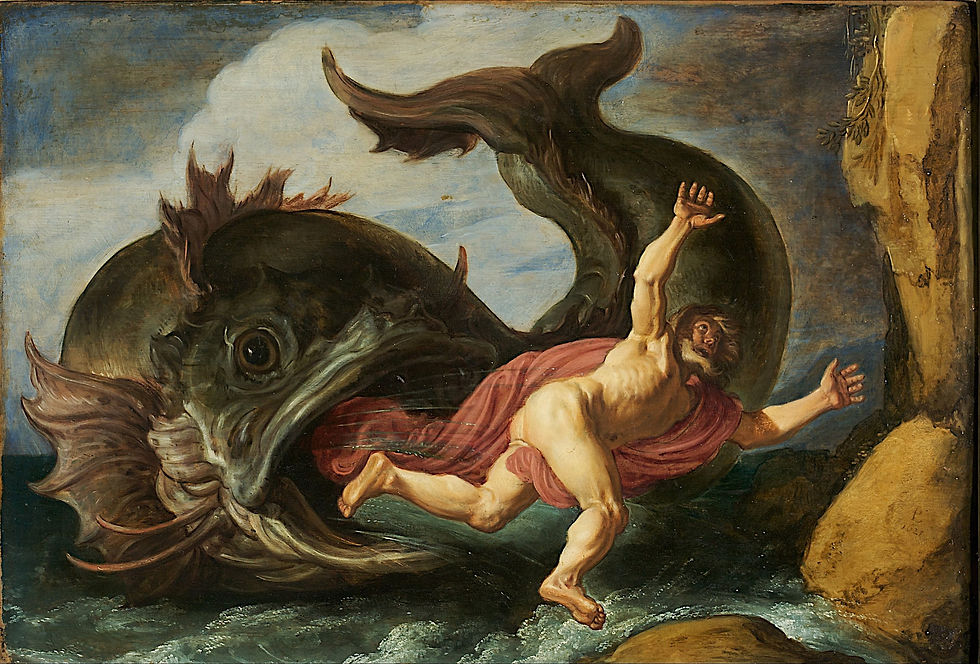An Evil Generation Seeks A Sign
- Deacon Dan DeLuca
- Jul 21
- 4 min read
Seeing is believing. That is what we are told, especially in our modern world. Yet Christ tells us that an evil generation seeks a sign. Christ also told the Apostle Thomas, “Blessed are those who have not seen and yet believe.” Yet modern man is so often quick to reject faith because so much is untestable or unseen (at least by modern eyes). Do you seek a sign, or do you believe?

Gospel - Matthew 12:38-42
Some of the scribes and Pharisees said to Jesus,
"Teacher, we wish to see a sign from you."
He said to them in reply,
"An evil and unfaithful generation seeks a sign,
but no sign will be given it
except the sign of Jonah the prophet.
Just as Jonah was in the belly of the whale three days and three nights,
so will the Son of Man be in the heart of the earth
three days and three nights.
At the judgment, the men of Nineveh will arise with this generation
and condemn it, because they repented at the preaching of Jonah;
and there is something greater than Jonah here.
At the judgment the queen of the south will arise with this generation
and condemn it, because she came from the ends of the earth
to hear the wisdom of Solomon;
and there is something greater than Solomon here."
Scriptural Analysis
The scribes and Pharisees address Jesus as teacher. In Matthew’s Gospel, Jesus uses this term to refer to himself; however, his disciples never do so. Instead, his adversaries address him this way, indicating that they are not sincere in their desire to learn but are rather looking for an excuse to condemn him.
They ask him for a sign, such as was given in the Old Testament, to validate a leader or a prophet. Jesus has already performed numerous signs, unlike anything ever seen in Israel. Despite this, the scribes and Pharisees are already plotting to kill him, having attributed his previous miracles to the devil, "It is only by Beelzebul, the prince of demons, that this man casts out demons.” (Matthew 12:24) It is unlikely that another miracle would have made a difference and would have likely been attributed to the work of the devil as well.
Jesus highlights the religious leaders’ hard hearts by referring to them as “an evil and unfaithful generation.” Just as the Israel of old was unfaithful to God’s covenant and was portrayed as an adulterous wife, the language used here also recalls the Israelites who wandered the desert, disinherited from the promised land: “Not one of these men of this evil generation shall see the good land which I swore to give to your fathers.” (Deuteronomy 1:35) Just as that generation saw many great signs and yet failed to believe, so too do the scribes and Pharisees risk being disinherited from the kingdom if they persist in rejecting Christ.
The only sign now given to the scribes and Pharisees is challenging to understand: the sign of Jonah the prophet. Jesus uses the story of Jonah’s life, in which he escaped death after being in the belly of a whale for three days and three nights, to foreshadow his death and resurrection. Jesus will triumphantly rise after being in the tomb for three days and three nights. It is this, his resurrection, that is the ultimate sign of his resurrection.
Jesus says that the Gentiles of the Old Testament will condemn this generation. The men of Nineveh repented upon the preaching of Jonah, and the Queen of Sheba traveled a great distance to hear the wisdom of Solomon. These Gentiles exhibited far greater faith than the scribes and Pharisees exhibited. If these Gentiles exhibited this faith in response to Jonah and Solomon, how much greater should the response of the scribes and Pharisees have been in the presence of Jesus? Yet they refused to accept him.
Daily Application
In his famous work, the Proslogion, Saint Anselm of Canterbury famously wrote 'fides quaerens intellectum' (faith seeking understanding). This saying captures the intimate relationship between faith and human reason. Saint Anselm would later clarify this relationship by stating, “I do not seek to understand in order that I may believe, but rather, I believe in order that I may understand.” Faith comes first, the believing; then understanding comes, the seeing.
This is what makes religion so difficult for some. We don’t start with an understanding and then seek a reason for that understanding. Instead, we begin with belief, the reason for everything, which is God. From that belief flows understanding. It allows us to understand who we are as sons and daughters of God. It informs our reason for our existence. It instructs us on how we should live our lives.
That is not to say that signs are still not granted to mankind. Consider, for example, the miracle of the sun which took place during the Marian apparitions at Fatima. Thousands of people witnessed this miracle, which was reported on in secular newspapers. Part of the canonization process requires two miracles to be attributed to the intercession of the individual being canonized. These miracles undergo rigorous scrutiny from the Vatican, trying to find a natural cause before they can be accepted as supernatural. Finally, consider your own lives. Although perhaps not as dramatic as these other miracles, if we allow ourselves to open our eyes and reflect, we will see the hand of God at work in small but no less substantial ways.
God grants us signs, but it is not the signs that should be the source of our belief. If our belief is based solely on signs, it will fade and weaken over time. Instead, our belief must be rooted in faith, a gift from our Lord that He grants to all of us, which draws us closer to Him. Modern man, an evil generation, seeks a sign. Don’t chase after signs or experiences. Instead, ask for the gift of faith and then come to understand.





Comments